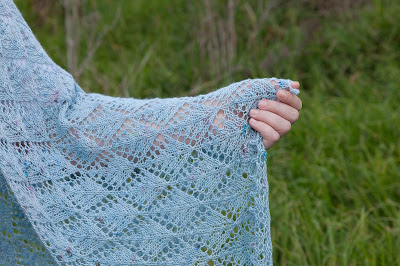 |
| Budburst shawl by Amy van de Laar |
The designs which are simplest to re-size have an all-over stitch pattern, and I'll be focusing on these since several of my shawl and wrap patterns are in this category. It gets a little more complicated if the edging contrasts with the main stitch pattern (e.g. my Silverwing shawl) - here you would need to consider how the proportions of the two sections will look if you enlarge one or both of them.
Let's take a look at a couple of common shapes and how to approach re-sizing them.
Triangles
Triangular shawls are usually easy to enlarge, because the cast on number does not affect the shawl's final size - you can simply knit extra repeats if you decide at any point that you'd like it to be larger.
If you have a precise final wingspan size you're aiming for (if for example you find a 65" wingspan easy to wear), and the shawl has the same stitch pattern throughout, you can calculate how many repeats to knit by measuring the size of one repeat on the diagonal. I'll be using my Budburst shawl as an example, which is a triangular shawl knit sideways from tip to bind-off edge, with an all-over lace pattern. This formula will also work for traditional top-down triangles (like Amarilli), and other triangles where the wingspan is diagonal to the direction of knitting.
 |
| Measuring a diagonal pattern repeat on a swatch |
One you know both the target wingspan and the size of one diagonal repeat, you can use this formula to find the total number of repeats to knit:
Desired wingspan size / diagonal size of one repeat = number of repeats.
If the answer is a fraction, round it up or down to a whole number.
Rectangles
Lengthening a rectangular wrap or scarf knit end-to-end is just as simple, because again you can simply knit extra repeats. Adjusting the width of a rectangle is a little trickier, because in this case the number of stitches you cast on does directly affect the final size. I'm using my Beeswax Scarf as an example here, which has an all-over stitch pattern and includes three width options from scarf to wrap.
If you want to widen a rectangle which is knit from end-to-end, you'll need to know two things before casting on:
- The width of one repeat (find this by swatching if you need precision, or take the info from the pattern if it's given), and
- The number of stitches in each repeat (find this from the gauge info in the pattern, or from the chart).
Desired finished width / width of one repeat = number of repeats.
If the answer is a fraction, round it up or down to a whole number.
Now you can calculate exactly how many stitches to cast on:
Number of repeats x number of stitches in one repeat = number of stitches to cast on.
Remember to add the edge stitches to this total, if any. They will add a little extra width.
Other shapes, like crescents, pi-shawls, and all the many weird and wonderful shapes knitters keep inventing, will need different approaches depending on their construction. I hope this partial guide has been helpful as an intro, and gives you an idea of which variables to look at when you want to change the size of a shawl.









